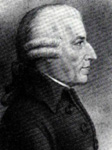John Howard
![Close-up of the statue of John Howard in Bedford [Z50/13/143]](/CommunityHistories/Cardington/CardingtonImages/Close up of the statue of John Howard in Bedford [.jpg)
Close-up of the statue of John Howard in Bedford [Z50/13/143]
A statue of the prison reformer John Howard stands in the market place in Bedford but he lived most of his life in Cardington. Bedfordshire and Luton Archives and Records Service has a copy of his Prisons and Lazarettos on the Searchroom shelves.
John Howard was born in London on 2nd September 1726, son of a nonconformist City merchant. His mother died shortly after his birth. Howard senior had property in Cardington and sent his son, who was a sickly child, there to be nursed by the wife of a tenant. His education took place in Hertford and London, however.
Howard’s father died when he was still a young man, leaving him with the Cardington estate and independent means. When he was twenty four he suffered a dangerous illness and was nursed back to health by a woman thirty years older than himself. He married her but three years later she died.
Howard then took a trip to Portugal but was captured and imprisoned by a French privateer. This was the turning point of his life because he was treated with such cruelty that he made up his mind to ease the sufferings of people in a similar position if ever he got the chance. When he was released he went back to Cardington and began to improve his father’s estate. This included building model cottages for his tenants. He was also a pioneer in scientific farming.
John Howard's kinsman and near neighbour Samuel Whitbread I also bought up property in Cardington. John Byng, 5th Viscount Torrington remarked in his diary that the friendly rivalry between the two major landowners was a benefit to the village, Cardington was: “a Village of much Neatness, with all Houses so smart, and the Green so nicely planted … This Church and the Church yard … are in the best conservation; for Messrs Whitbread and Howard being at variance (luckily for the Village) strive which shall most benefit and adorn it: consequently the Cottages are neat and comfortable; For what cannot the Riches of the one, and the Charity of the other, accomplish?”
He married again in 1758, the new Mrs. Howard being Henrietta Leeds, daughter of a lawyer from Croxton in Cambridgeshire. He had bought Howard House in Cardington in 1757 and remodelled it as the new family dwelling. Sadly it did not serve that purpose very long. Henrietta’s health was poor and they moved to Hampshire to a milder climate. When this had no beneficial effect they moved back to Cardington but Henrietta died in 1765 soon after giving birth to their child. She was duly buried in Cardington church. The son developed mental instability and spent the last thirteen years of his life in an asylum in Leicester. He died in 1799 and the body was bought home to Cardington for burial.
When at Cardington John Howard worshipped at the Independent Chapel where John Bunyan had preached in the previous century. Howard presented a new pulpit to the meeting in 1770. Two years later the thorny subject of infant baptism split the congregation and Howard, who was in favour of the idea, gave £200 for the building of what became known as the Howard Meeting in Mill Street, Bedford.
In 1773 Howard was made High Sheriff of Bedfordshire and took the opportunity to examine the conditions in Bedford Gaol, at that time at the junction of Silver Street and the High Street, the place in which John Bunyan had been imprisoned. The prison comprised two dungeons, each eleven feet below ground and both male and female prisoners shared a small exercise yard. Even if a prisoner was found not guilty at trial he had to pay 15/4 to the gaoler and two shillings to the turnkey before he was released.
The last sixteen years of John Howard’s life were spent on his self-appointed task of improving conditions of prisoners. Cardington remained his home but he was often absent on journeys around not only England but Europe too. In 1774 he was called to give evidence to the House of Commons and thanked for his endeavours by the Speaker. He was helped financially in his campaign by his relative Samuel Whitbread I.
In 1789 he travelled to Russia and was inspecting prisons in the south of the country when he contracted a fever commonly called gaol fever, or typhus. He died in Kherson, then in Russian Tartary, now in Ukraine on 20th January 1790, aged 63 and was buried overlooking the sea at a place called Stepanovka. A monument to him was subsequently erected in Kherson. John Howard's estates eventually passed to Samuel Charles Whitbread, grandson of Howard’s friend and relative Samuel Whitbread I.
In 1821 an impressive memorial to Howard was unveiled at Kherson. By 1990 it was in a dilapidated state and was restored fir the bicentenary of his death. John Howard’s statue in Bedford was unveiled on 31st March 1894. The Bodleian Library in Oxford has some of Howard’s correspondence, journals and other papers from 1760 to 1789, found in 1955 with papers of the late Mrs. Barnardiston of Sudbury [Suffolk], great-great-granddaughter of Henrietta Howard’s sister Anne.
 An engraving of John Howard by Freeman
An engraving of John Howard by Freeman